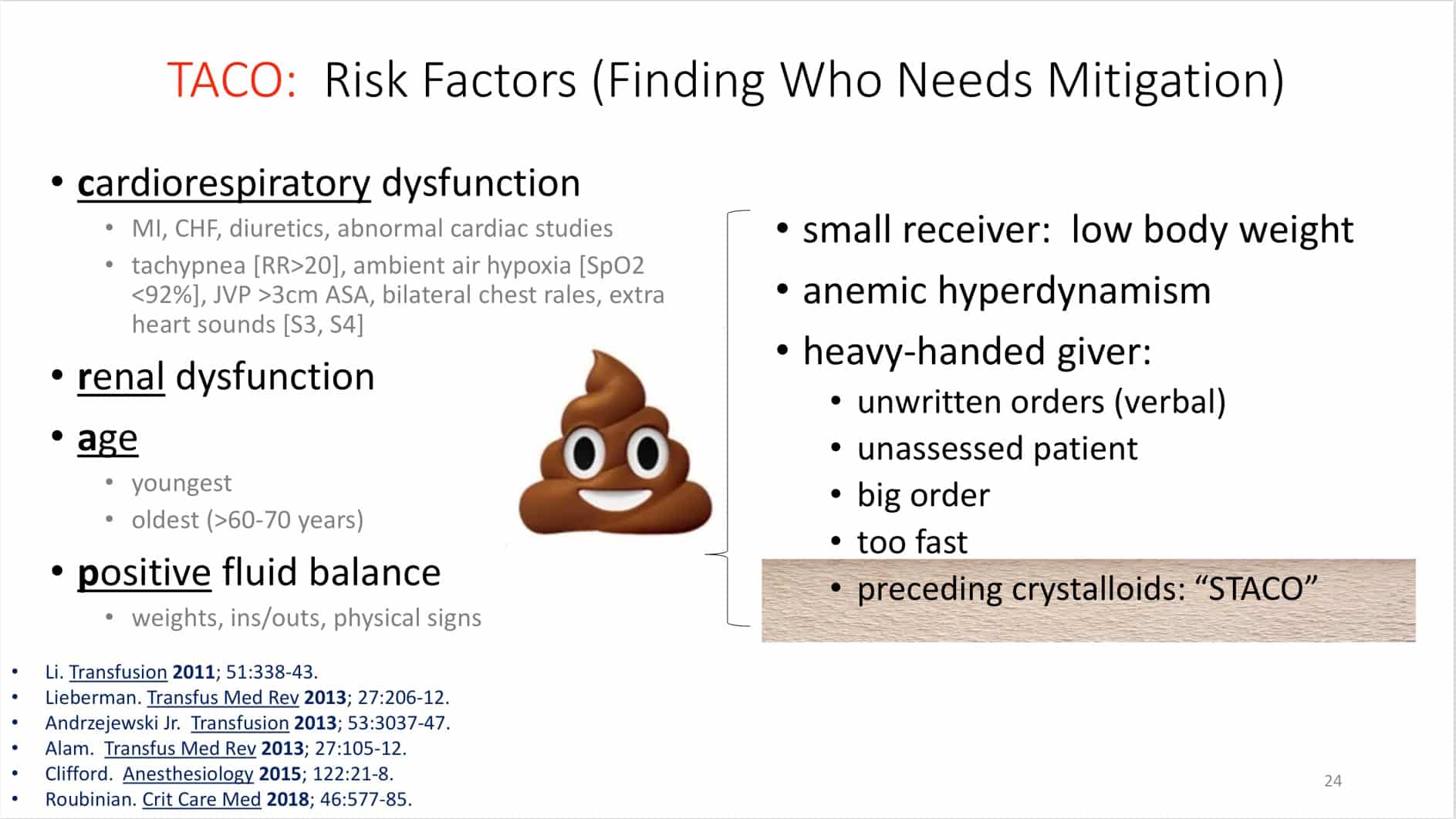Transfusion reactions that involve the lungs and heart cause major problems; in fact, such reactions are the most common cause of transfusion-associated death!

Dr. Christine Cserti-Gazdewich
Why They Matter
Transfusion-associated circulatory overload (TACO) and transfusion-related acute lung injury (TRALI) are reactions that happen more often than we would like, and they may result in significant cardiorespiratory compromise. TACO and TRALI, in fact, are the numbers 1 and 2 on the list of transfusion-related death in most countries in the world! Unfortunately for us, there is quite a bit of overlap in how these two reactions appear initially, and distinguishing between them can be tough. This interview seeks to outline clinical, radiologic, and laboratory criteria for diagnosis of both TACO and TRALI (focusing mostly on TACO), so that you can better identify, manage, and prevent these dangerous reactions.

Dr. Christine Cserti-Gazdewich
Why They Matter
Transfusion-associated circulatory overload (TACO) and transfusion-related acute lung injury (TRALI) are reactions that happen more often than we would like, and they may result in significant cardiorespiratory compromise. TACO and TRALI, in fact, are the numbers 1 and 2 on the list of transfusion-related death in most countries in the world! Unfortunately for us, there is quite a bit of overlap in how these two reactions appear initially, and distinguishing between them can be tough. This interview seeks to outline clinical, radiologic, and laboratory criteria for diagnosis of both TACO and TRALI (focusing mostly on TACO), so that you can better identify, manage, and prevent these dangerous reactions.

About My Guest:
Christine Cserti-Gazdewich is a transfusion medicine specialist and consultant hematologist, originally trained in internal medicine and clinical hematology in Toronto, with fellowship training in transfusion medicine at Harvard. Based at the University Health Network for 14 years, she co-directs a large blood transfusion service through several teaching hospitals of the University of Toronto, with oversight responsibilities to a number of community/rural client sites across the province too. Her chief interests in practice, leadership, and research are in immunohematology, hemovigilance, and complex/constrained hemotherapy scenarios.
Continuing Education Expired
This podcast episode offered continuing education credit for two years from its release date, but is no longer eligible for such credit.
To find Blood Bank Guy Essentials Podcast episodes with active continuing education opportunities, Click here or visit Transfusion News Continuing Education on Wiley Health Learning.
DISCLAIMER: The opinions expressed on this episode are those of my guest and I alone, and do not reflect those of the organizations with which either of us is affiliated. Neither Dr. Cserti-Gazdewich nor I have any relevant financial disclosures.
The images below are generously provided by Dr. Cserti-Gazdewich.
Further Reading:
- Cohen R et al. Serologic assessments in acute transfusion reactions: practices and yields. Vox Sanguinis 2019;114:749-761
- Vlaar et al. A consensus redefinition of transfusion-related acute lung injury. Transfusion 2019; 59(7):2465-2476
- Parmar N et al. The association of fever with transfusion-associated circulatory overload. Vox Sanguinis 2017;112:70-78
- ISBT Working Party on Hemovigilance. Transfusion-associated circulatory overload (TACO) Definition (2018)
- United States FDA: Fatality Report Fiscal Year 2018
- United Kingdom Serious Hazards of Transfusion Annual Reports
- Canada Transfusion-transmitted Injuries Surveillance System; 2009—2013 Summary Results
Thanks to:
- Samantha Chaffin, Design and content consultant
Music Credit
Music for this episode includes “Cuando te invade el temor” and “Reflejo,” both by Mar Virtual via the Free Music Archive. Click the image below for permissions and license details.


















Hello,
I believe there are a couple of issues with the latest CE (89CE, Transfused and Breathless).
1) The title on Wiley activity page for the episode is wrong (it has the title of the last episode but the content is from this episode).
2) The text of the first question in the assessment is from the Sepsis episode, but the available answers to that question are from the TACO/TRALI episode.
Thank you for doing this! I find it extremely valuable for my education and in my work as a hospital laboratory manager.
I have notified Wiley Health of the issues on their site, David. Thanks for letting me know.
-Joe
I’ve confirmed that Wiley has updated their site. Thanks again for letting me know.
-Joe
Based on the 2018 definition of TACO, it is required to have one of two features, respiratory distress or pulmonary edema with one or more of three other features. if I am understanding this correctly and respiratory distress or pulmonary edema is required for the definition of TACO, then how come it says differently on the last chart titled “together”?
Thanks Rajat for your question & the careful reading! The “Together” panel is derived from the Vlaar et al TRALI re-definition paper, and it does not speak to the sum of all available criteria required to properly fulfill definitions in any of the reaction categories shown in the columns.
Instead, the table aims to compare/contrast key elements for distinguishing vs non-distinguishing features.
The TACO definition does not technically/specifically require hypoxemia (compared with TRALI, where it is an essential part of its definition), referencing the 2018 ISBT working party definition / the 2019 Wiersum-Osselton paper [Revised international surveillance case definition of transfusion-associated circulatory overload: a classification agreement validation study, LANCET Haematology]). We therefore need other things in the key criteria-boxes, eg – non-hypoxic dyspnea can be your observed form of “respiratory distress,” or physical exam features of pulmonary edema such as new crackles not explained by other entities may be your best alternative to the radiograph in the “pulmonary edema” box. In other words, the TACO criteria in “respiratory distress” or in “pulmonary edema” are much more inclusive with low-tech (physical) and high-tech (oximetry, radiology) options for the assessor in any environment (low-resource or high-resource) to make a considered judgment. We want to identify these cases as best we can to better understand true counts… and for the hope of taking better actions from there!
Yet another fantastic podcast. Thanks for bring Dr Cserti-Gazdewick back to discuss TACO& TRALI, she is covers the topic so well.
Hello,
Thank you for a great podcast!
The CE site is not working today….Can please you look into it? Thanks!
To receive credit and review the accreditation information and related disclosures, please visit Transfusion News Continuing Education on Wiley Health Learning.